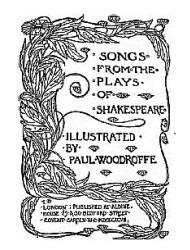Songs from the Plays of Shakespeare
(1898)
Illustrated by Paul Woodroffe
A rare copy of Songs from the
Plays of Shakespeare published at
Aldine House (London) in 1889.
This copy shows the original unassuming blue cloth cover.
To the right, we show the
decorated Title Page for the 1st Edition
of Songs from the Plays of
Shakespeare by Paul Woodroffe.
Songs from the Plays of Shakespeare is a
collection drawn together and introduced by Ernest Rhys, and in respect of the
Edition published at Aldine House (London) in 1889, a
number of the songs are accompanied by major monotone
illustrations by Paul Woodroffe.
Rhys'
Introduction to
Songs from the Plays of Shakespeare makes wonderful reading - particularly in respect of
his
summary of the literary value of the Songs .
To accompany Songs from the Plays of Shakespeare ,
Paul Woodroffe
prepared a suite of 12 ornate major monotone
images with additional marginalia. Each of the major
illustrations is presented with Pre-Raphaelite style and accompanied
by an integrated decorated border - with each border
being unique to the associated illustration.
Our Greeting Cards and Reproduction Prints
We have prepared sets of 12 Greeting Cards displaying
each of Woodroffe's major monotone images for Songs from the Plays of
Shakespeare (1898) and on the left, we show an example of how these Greeting
Cards appear. Ordering one of those sets is as easy as selecting the "Add to
Cart" feature below and following the prompts provided with our Shopping Cart
secured through PayPal. Multiple purchases will
be consolidated by that feature and shipping and handling costs to any destination in the world are accommodated by our flat-rate fee of US$20 for every
US$200 worth of purchases.
Code: PW
SPS
MS(12)Price: US$60.00
When presented on Greeting Cards, these
images are prepared as tipped-in
plates - in homage to the hand-crafted
approach typical
of prestige illustrated publications produced in the early decades
of the 20th Century.
Hand-finishing is used to replicate the
visual appearance of a tipped-in plate and the images are presented
on
Ivory card stock (in the case of colour illustrations) or White
card stock (in the case of monotone illustrations)
with an accompanying envelope. We have left the cards blank so that you may write your own personal
message.
Should you wish to order a Reproduction Print of one or more of these images, we have provided some
options below. Of course, should you wish to
discuss some customised options, we welcome
your contact
on any matter through
ThePeople@SpiritoftheAges.com
In the meantime, enjoy perusing these wonderful images
from Paul Woodroffe.
The major monotone illustrations
Full image
You spotted
snakes with double tongue
You spotted snakes,
with double tongue,
Thorny hedgehogs, be
not seen;
Newts and
blind-worms do no wrong,
Come not near our
fairy Queen!
Weaving spiders,
come not here;
Hence, you long-legg'd
spinners, hence!
Beetles black,
approach not near;
Worm not snail, do
no offence.
Philomel, with
melody
Sing in our sweet
lullaby;
Lulla, lulla,
lullaby, Lulla, lulla, lullaby:
Never harm
Nor spell nor charm
Come our lovely lady
nigh:
So, Good Night, with
lullaby.
Detail (for
reference)
Reproduction on
10x15" sheet
Code: PW SPS M1 (10x15)Price: US$50.00
Full image
It was a lover
and his Lass
It was a lover and
his lass,
With a hey, and a
ho, and a hey nonino,
That o'er the green
corn-field did pass,
In the spring time,
the only pretty ring time,
When birds do sing,
hey ding a ding, ding;
Sweet lovers love
the spring.
Between the acres of
the rye,
These pretty country
folks would lie.
This carol they
began that hour,
How that life was
but a flower:
And, therefore, take
the present time
With a hey, and a
ho, and hey nonino;
For love is crown
and graved with the prime
In the spring time,
the only pretty ring time,
When birds do sing,
hey ding a ding, ding:
Sweet lovers love
the spring.
Detail (for
reference)
Reproduction on
10x15" sheet
Code: PW SPS M2 (10x15)Price: US$50.00
Full image
Sigh no more,
ladies, sigh no more
Sigh no more,
ladies, sigh no more, -
Men were deceivers
ever,
One foot in sea and
one on shore,
To on thing constant
never:
- Then sigh not so,
but let them go,
And be you blithe
and bonny;
Converting all yours
sounds of woe
Into, Hey nonny,
nonny.
Sing no more
ditties, sing no more,
Or dumps so dull and
heavy;
The fraud of men was
ever so,
Since summer first
was leafy.
- Then sigh not so,
but let them go,
And be you blithe
and bonny,
Converting all yours
sounds of woe
Into, Hey, nonny,
nonny.
Detail (for
reference)
Reproduction on
10x15" sheet
Code: PW SPS M3 (10x15)Price: US$50.00
Rhys'
Introduction to Songs from the Plays of Shakespeare
The lovely introduction provided by Rhys to the
collection - and the images by Woodroffe - follows.
Ariel, who is the essential sprite of song, has often
been attempted, if never entirely captured,
in picture; and the same may be said of
Shakespeare's Songs . They lure every generation in
turn to give them a pictorial and musical setting,
after its own fashion. Fashions change; the
charm of these Songs , and their lyric
fascination, are constant. The new presentment may not
be, is very unlikely to be, the final and perfect one.
It is pretty certain to be very unlike
Shakespeare's idea, conceived in Elizabethan terms of
music or colour, of his own Songs set
to a lyric of pictorial accompaniment. Still, if it is
good, in its kind, the setting serves to make
us turn to the original Songs with a new sense
of their delightfulness; and that is enough.
The wonderful thing about the Songs is, that
separated from their context in the plays - where
their extreme felicity, dramatically considered, made
one dwell mainly upon their stage merit -
they should still strike one as so perfect in
themselves. This sets aside the cavil of the Scottish
critic who maintained that Shakespeare's Songs
would not bear mention in the same breath
with Burns - save for the lustre of their dramatic
framework. Better to consider how both
wrote songs so inimitably, and both purely as
song-writers, not as lyric poets in our later sense.
As for Shakespeare, we may be sure that, though the
names of his tunes are not given, he had
a tune in his head for every song her wrote. The
ballads heard at Stratford fairs, or the songs
caught from the mouths of the "beggar-men of Chepe," or
the folk-tunes sung by some
Warwickshire Autolycus, served him well. Tunes like
"Lady Greensleeves," "Crimson Velvet,"
"Light o' Love," "Three Merry Boys," and "The Bailiff's
Daughter," and the familiar melodies of
many a carol, and many an old country dance and
fiddler's jig, waited to prompt his fancy at
the exigent moment. The Duke in "Twelfth Night" may
show you how good a prompter
Shakespeare's memory was in these things, when he calls
again for "the song we had last night,"
a song which happens to be one of the most tender and
finely cadenced of them all, "Come
away, come away, Death!" The little prelude and
commentary the Duke offers upon it is in the
true connoisseur's view, idiomatic as the lines that
follow:
"Mark it, Cesario, it is ole and plain:
The spinsters and the knitters in the sun,
And the free maids that weave their thread with bones,
Do us to chaunt it: it is silly sooth,
And dallies with the innocence of love
Like the old age."
Those plays in which Shakespeare makes the most use of
the lyric leaven, using it not only for
songs, but for passages of a sort of free recitative,
or again of an unusual overflow of rhyme,
such as "Love's Labour's Lost," "The Midsummer Night's
Dream," and "The Tempest," are
divided in point of time by such long intervals that
the critic who would base any theory upon
the chronology of the songs would be bold indeed. In
any case, the reader here, looking at
them through the agreeably uncritical medium of
delightful illustration, would be likely to
resent any attempt to bring the rules of the great
Shakespearean critics into the question. Other
poets than he, when the ebullience and heat of youth,
and all its gay or sorrowful impulsiveness,
were gone, may have lost their lyric grace and power.
Shakespeare remembered his tune,
whether of last night, or thirty years ago, and wrote
his song, whether to fit the earthly
humours of a grave-digger or the airy spirit of an
Ariel, in just as well and beseeming a vein
apparently at the last as at the first. The rhymer in
him may a little have decayed; the lyric poet
and the song-writer never - so far at least as we can
judge.
For Ariel, the last consummate creature of his lyric
imagination, comes at the last. He is the
spirit of all the airy harmonies and all the fugitive
half-recollected tunes, one has ever heard or
dreamt. Everything he utters has something of the
inevitable lyric essence in it. "I drink the air
before me" is his promise of good speed. The same sense
of airy movement, and free passage,
such as a song itself may win on the clear airs of
sea-shore or hill-tip, is in all his fluent exits and
entrances; as where we find him described, when leading
Ferdinand by the sea-shore, as
"invisible, playing and singing." What elusive
harp-strain, flying on from one ripple of silver
strings to another, such as he may have heard from some
Welsh triple-harp in the West Midlands,
had Shakespeare in his mind as he wrote the lines that
the scene ushers in?
"Come unto these yellow sands,
And then take hands:
...
Foot it featly here and there,
And sweet sprites the burden bear."
So far as the stage could possibly suggest such things,
the appearance of Ferdinand, sitting and
listening there, suggests the loneliest of lonely
sea-places. But one hardly bears to read "The
Tempest" as a stage-conditioned piece of art. It is a
poem, that one recollects rather with the
poetry that is, like the best of Shelley and
Wordsworth, to be felt under quite another range of
association than even the most ideal theatre can
furnish. And so with Ferdinand's speech, sequent
to the "Yellow Sands" melody:
"Where should this music be? i' the air or th' earth?
...
This music crept by me upon the waters,
Allaying both their fury and my passion
With its sweet air; thence I have followed it,
Or it hath drawn me rather: but 'tis gone -
No, it begins again."
Then come the famous "Full fathom five" lines - "the
ditty" which, says Ferdinand so imaginatively,
"does remember my drown'd father." In all this there is
an art almost transcending art. It is like
something struck out of nature, in a radiant changing
imagery. And it is the sense of such
unforgettable melody, caught in a dramatic pause, like
a fragrance of distant hay-fields caught at
a town window by night, that makes these songs, like
Ariel himself, so elusive - at once so
tempting and so tantalising. Art, pictorial or music,
may succeed in interpreting them; it is certain
that criticism, however, ardent, can do little with
them.


%20(sample).jpg)
.jpg)
%20(250).jpg)
.jpg)
%20(250).jpg)
.jpg)
%20(250).jpg)